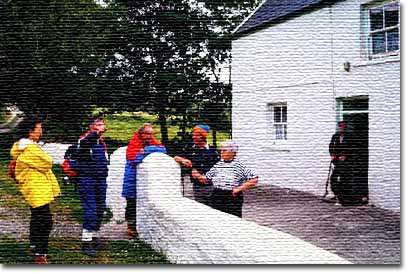 |
| Walking around Rossnowlagh |
| Reynold's Folly When walking towards Ballyshannon, just after passing the Friary, you will see a tower-like building standing on a hilll to the left - this is known locally as the Tower, the Folly, or Reynold;s Folly. During earlier days of the last century, a family of gentry called Reynolds lived on the other side of the hill, but the gate house at the entrace had a very poor view. According to locals, as there was a good view from the top of the hill, the family decided to build a sitting room there, which they could bring visitors to, hence the Tower. |
 |
| Lurgan Cairn The best view to be seen within walking distance of Rossnowlagh is from Lurgan Cairn. To get there, take the road to the right at the cross-roads near the hotel and continue across the road leading to Ballyshannon. Go up over a bridge (once a railway bridge). After about a mile, you will notice some stones on the left, in a field a few yards from the road. A few hundred yards after passing these, take a road to the right. After another few hundred yards along this road an iron gate leads into a field on the left. Pass the first iron gate and take the second gate to enter the fields, making sure to shut the gate. Carry on upwards to the top of the hill, which is marked by a little cairn and a small obelisk 492 feet above sea level. On a clear day, with good visibility, portions of at least 6 counties (Donegal, Tyrone, Fermanagh, Cavan, Leitrim and Sligo) are visible. You can also see a long range of South Donegal mountains from Slieve League to Barnesmore, and a large part of Donegal Bay, including the wooded island known as Bell's Isle, and St. Ernan's. The outline of the Mayo coast can sometimes be seen, with the mountain Nephin rising in the shape of a clamp of turf. The return journey is about 4 miles. |
| Kilbarron Castle If you look in a south-westerly direction from Rossnowlagh, a blackened pillar, rather like a chimney, is visible where the view of the cliff ends. This is the remains of Kilbarron Castle. In past times there was a well-beaten path along the cliffs to it but this path has fallen into disuse. The ruin is most easily accessible by walking along the cliffs from the area of Creevy Pier. The Castle is believed to have been built about the 13th or 14th century and Michael O'Clery, one of the Four Masters, writers of the famous 'Annals of the Four Masters' was born in the castle about 1580. The remaining part was built before 1609. |
| The Creek The rocky inlet known as The Creek is an attractive place which is frequently used for bathing. Interesting shells and some rare specimens of plants may be found. Dulse can also be gathered and children can catch shrimps in the rock pools. From the beach, go up the slope known as Belalt Brae (the strand was formerly known as Belalt Strand) and turn right onto the road. This road, known locally as the Rock Line, will bring you along the top of the cliffs from where there is a beautiful view. Pass several houses and Smuggler's Creek Inn, you will reach a sharp bend in the road. A short road leads seaward - keep right over a small grassy patch to a steep pathway leading downwards towards The Creek. |
| The Churches There are three Churches in Rossnowlagh, all within walking distance of Rossnowlagh. Walk across the beach in a southerly direction, towards the cliffs, brings one to a slope leading to the roadway. Turn right at the top of the slope and take the next turn left, into the beautifully-kept grounds of the Franciscan Friary. The museum at the Friary is also worth a visit. At the Friary's front gates, turn left onto the Ballyshannon-Ballintra road. About 200 yards past the Friary the attractive Presbyterian Church is on the right hand side. About half a mile further on the Church of Ireland is situated, surrounded by a well-kept graveyard. Turn back towards Ballyshannon when you leave the Church grounds and take a right turn at the T-junction a few hundred yards along to return to Rossnowlagh. |
| The Strand The strand offers one of the most popular walks in Rossnowlagh. Walking northwards from the Sand House Hotel, away from the cliffs, one will come to a large block of cement, partially submerged in the sand. This relic of the Second World War was actually a 'pill-box' originally built on the edge of the bank in 1940 to defend the strand from invading planes. Its present position gives a good idea of the erosion which has taken place since then. Around the headland, the shore becomes more stony and further on, around a couple more corners, lies the 'Loop Strand' or the 'Cockle Strand', as it was formerly known as locals and visitors alike have traditionally dug in this area for the succulent shellfish. The Cockle Strand is about 2 miles from the centre of Rossnowlagh. Further along the strand a channel indicates where Durnesh Lake runs into the sea Warning: About 20 yards from the lake end of the channel, there is a very dangerous hole. Be very careful if exploring in this area, and children should be kept away from this part. After crossing the channel the walker will come to Inishfad, a great place for finding cowries, and other shells. Inishfad is about 3 miles from Rossnowlagh, and it is possible to walk much further round to Murvagh Beach. |
| Click here for map with places of interest |
| Click here to return to Derek's Home Page |